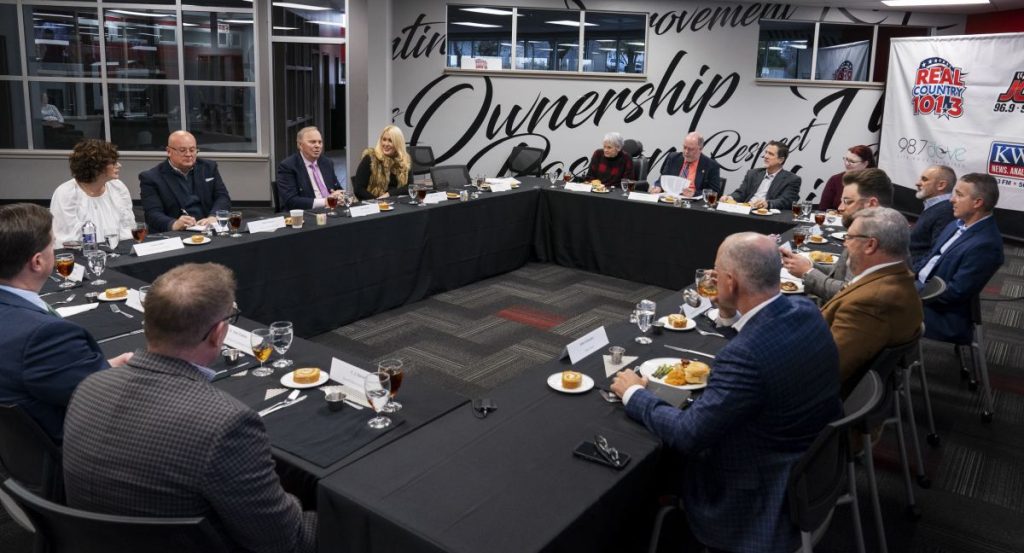Nearly a dozen local leaders from local government to real estate, education, development, tourism, insurance, and the chamber of commerce will gather Thursday at our KWTO studios for our quarterly CEO Roundtable.
Some of the topics our panelists will discuss include whether a recession is likely in 2023, and if so, how will it compare to the one we experienced in 2008?
We’ll get a 2023 industry forecast from our CEO’s, discuss what steps should be taken to attract and retain top talent in the Springfield workforce, and how cyber-crime affects local industries.
Our panelists for Thursday’s CEO Roundtable include Springfield City Manager Jason Gage, Republic City Administrator David Cameron, Diane Nicholas with Murney Associates Realtors, Drury University Breech School of Business Dean Dr. Jeffrey Zimmerman, Curtis Jared with Jared Enterprises, Jeff Layman with FORVIS, Springfield Chamber of Commerce President and CEO Matt Morrow, Branson/Lakes Area Chamber of Commerce CEO Jason Outman, Andrea Croley, co-owner of Croley Insurance, SPS Foundation Development Director Tina Pham, and OTC Director of Diversity and Equality Daniel Ogunyemi.
As we look ahead to Thursday’s panel, here’s a recap of our last CEO Roundtable in November, 2022:
The Future of Development in Springfield
Area Leaders Discuss Path Forward After Fall Election.
By Madeleine Leroux
Photos by L.G. Patterson
Springfield area business leaders are grappling with how future development will be handled, and received, after a years-long development attempt ended in failure at the ballot box.
KWTO Radio hosted a CEO Roundtable luncheon in mid-November with attendees who ranged from young professionals to small business owners and education officials. The meal was catered by Simply Delicious Catering and hosted by Zimmer Communications Market Manager Carla Leible. The discussion was moderated by Don Louzader, operations manager for Zimmer Communications’ Springfield stations.
DEVELOPMENT DIFFICULTIES
Bryant Young, owner of Insurors of the Ozarks, says Springfield has unfortunately developed a reputation for being difficult for developers, pointing to the controversy and resulting election regarding the proposed development in Galloway Village.
The proposed development included storefronts and a four-story apartment complex with roughly 100 units on a property on South Lone Pine Avenue across the street from Sequiota Park. Developer Mitch Jenkins had worked with the city and secured approval for the project from the Planning & Zoning Commission and the Springfield City Council, but was met with significant opposition from the neighborhood. Members of the opposition group successfully placed the property’s proposed rezoning on the ballot, though it was tied up in litigation initially. After a lengthy court battle, voters in early November overwhelmingly rejected the rezoning needed for the development.
Young said the outcome is a frightening warning to other developers who may hesitate to invest in Springfield because “the process can go awry at the last second,” even when doing everything right.
Such a turn can have drastic effects on a young company, says Sam Coryell, founder and president of TLC Properties. If his company had to deal with a similar situation when starting out, “we would have been knocked out,” Coryell says.
The issue highlights the fact that Springfield is essentially maxed out on available land that offers a blank landscape to work with, says Ryan Allison, an advisor with Ollis/Akers/Arney Insurance and Business Advisors. That means developments must be built around existing neighborhoods and what happened with the Galloway development makes it that much harder to convince developers that it’s even an option, he says.
Callie Carroll, VP of Business Development and Shareholder Relations Officer, says what happened with Galloway specifically shows the overall problem in Springfield when it comes to communication and packaging. “We’ve allowed other people to write the narratives,” she says. “That’s an issue.” Misinformation spreads easily and any lack of or gaps in communication leave opportunities for myths to build, she says.
With Galloway, it came back to one-to-one communication, says Springfield Chief of Police Paul Williams. That is what ultimately defeated the proposed development. “It’s very, very difficult to recover from that,” Williams says.
BUILDING THE WORKFORCE
The overall issue of communication also affects the local workforce and talent pool. Allison says communication and education is needed about the opportunities afforded by staying in Springfield, but too many young people stay in their own bubbles, often missing a lot. “We do a very poor job of getting our young people outside of what they know,” Allison says. “They have blinders on.”
Carroll agrees, noting that outreach especially needs to be done with the college students in the community whose worlds are so small. Most, she says, have not ventured outside of downtown Springfield and don’t truly know what the community can offer them after graduation.
And that’s where businesses come in. By getting more businesses engaged with students before graduation, Carroll says more are likely to stay.
Kirk Elmquist, executive director of the Branson Lakes Area Tourism & Community Enhancement District, says incentives need to be offered to high school graduates to stay in the Ozarks area. Young people need to be encouraged to stay after schooling is complete and get a job or invest in a local business, he says.
Dr. Brad Johnson, president of the College of the Ozarks, says encouraging more collaboration between educational institutions and businesses is what’s needed in order to prepare the next generation of the workforce. But that collaboration has to keep in mind the wants and needs of the younger workforce.
Dr. Matt Hudson, executive dean of career, technical and community development at Ozarks Technical Community College, or OTC, says the product they deliver at OTC has changed, as it needed to, and employers must change with it. “We’re seeing some incongruencies about what work culture is and what young professionals expect,” Hudson says. Too many employers are continuing to operate under old models that expect applicants to simply appear on their doorstep, when that is no longer the case, Hudson says. And that disconnect is what Hudson sees as the true root cause of the workforce issue. “The workforce problem is not these young kids or these retirees that have left, it’s really the entire dynamic,” he says.
When it comes to continuing education, John Griesemer, president and CEO at Erlen Group of Companies, says one issue is that it typically hasn’t been built for the nontraditional student. Class schedules can be very difficult to accommodate for many working adults, which hinders their ability to advance.
Hudson agrees, noting that night school has essentially disappeared, making those collaborations between businesses and educational institutions all the more important. It’s through those types of programs that new workforce opportunities can be created, he says, but you have to start by training people where they are. Companies also would be better served by showing an emphasis on continuing education by sponsoring employees, Hudson says. “There are a lot of underemployed people in this community,” Hudson says.
Young points to organizations like The Network and the Roratact Club of Springfield that focus on identifying, training and networking young professionals in the area as key in developing the next generation of leaders. “Talent attraction and retention is important for the future of Springfield,” Young says. “We need to make Springfield and the greater Ozarks the place where people want to live, work and play.”
That’s why a focus on culture is so important when it comes to recruiting prospective employees to the area. C.J. Davis, president and CEO of Burrell Behavioral Health, says of the Burrell locations, Springfield is the easiest place to recruit new employees. And that comes back to the culture of not only the area, but the company itself and a focus on building from within. Davis says they focus on training existing employees to help them move forward in their careers and the company. “Culture eats strategy for breakfast,” Davis says.
It’s a lesson the local police department has already taken to heart, Williams says. As much as everyone has struggled with workforce in the last couple of years, Williams says it has been particularly difficult for law enforcement. But the department changed its tactics, he says, switching to a focus on selling Springfield as a community to new recruits and then selling the department itself. The changes have paid off for the Springfield Police Department, which now averages 20 recruits testing per month, up from just six per month two years ago. “There’s nobody recruiting at the level we are,” Williams says. “This is a fantastic community. … We don’t sell ourselves enough.”
Jeff James, president at American Print Products, says he’s watched the city grow throughout his life and, once people see how great Springfield and its people are, they will want to invest in the community. “We need to communicate who we are,” James says.















